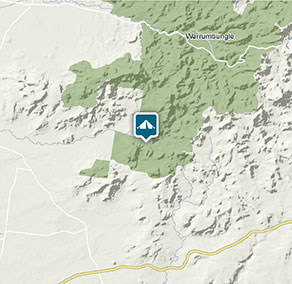Gunneemooroo campground
Warrumbungle National Park
Visitor info
All the practical information you need to know about Gunneemooroo campground.
Getting there and parking
Gunneemooroo campground is in the Gunneemooroo precinct of Warrumbungle National Park. The campground is only accessible by 4WD vehicles.
To get there from within Warrumbungle National Park (eastern approach via Coonabarabran):
- Travel on John Renshaw Parkway over the western boundary, taking the turn towards Tooraweenah
- Turn left onto the unsealed Mount Terrace Road which takes you into Gunneemooroo campground.
To get there from Tooraweenah:
- Travel west along John Renshaw Parkway for 14km
- Turn right onto the unsealed Mount Terrace Road which takes you into Gunneemooroo campground.
To get there from Coonamble:
- Travel east on the Coonamble Tooraweenah Road for 59km until you reach the Cummin Crossroad
- Turn right, towards Tooraweenah, and travel for 16km
- Turn left onto the unsealed Mount Terrace Road which takes you into Gunneemooroo campground.
Road quality
Check the weather before you set out as the road to Gunneemooroo campground can become boggy when it rains.
Access is via 2 creek crossings. Wet weather can cause flash flooding, cutting off all access in and out of the campground. As a result the campground may close and bookings may be cancelled at short notice.
- Unsealed roads
Vehicle access
- Most roads require 4WD vehicle
Weather restrictions
- Dry weather only
Parking
There is parking at the campground for 4WD vehicles. 2WD vehicles will need to park at the gate, which is located 3km from the campground.
Best times to visit
You may experience a great range of temperatures on any day in the park. In summer it's generally hot in the daytime and temperatures often exceed 30C. In contrast, winter can be very cold and the temperature drops below freezing at night. Rainfall is also highly variable, ranging from drought to prolonged wet periods. Less rain falls on the western side of the park than on the eastern side. It rains most from December to February and the annual average rainfall is 720mm. Thunderstorms are common in mid to late summer.
Spring
During early spring wildflowers are in bloom, including a huge variety of golden wattle flowers With a more moderate climate, spring is a great time to get out and camp under the stars .
Weather, temperature and rainfall
Summer temperature
Average
15°C and 30°C
Highest recorded
42.6°C
Winter temperature
Average
0°C and 15°C
Lowest recorded
-9°C
Rainfall
Wettest month
January
Driest month
September
The area’s highest recorded rainfall in one day
176.3mm
Facilities
- Tank water is available at this campground, but you’ll need to treat or boil it before drinking. Please note that the tank is reliant on rainfall to fill, therefore water may not be available at time of your visit.
- Rubbish bins are not available – please take rubbish with you when leaving.
Toilets
- Non-flush toilets
Maps and downloads
Prohibited
Drones
Flying a drone for recreational purposes is prohibited in this area. Drones may affect public enjoyment, safety and privacy, interfere with park operations, or pose a threat to wildlife. See the Drones in Parks policy.
This area may be a declared Drone Exclusion Zone, or may be subject to Civil Aviation Safety Authority (CASA) rules for flying near airports, aerodromes and helicopter landing sites. See CASA's Drone Flyer Rules.
Commercial filming and photography
Commercial filming or photography is prohibited without prior consent. You must apply for permission and contact the local office.
Gathering firewood
Firewood is not provided and may not be collected from the park.
Generators
- Generators are not permitted in this campground
Pets
Pets and domestic animals (other than certified assistance animals) are not permitted. Find out which regional parks allow dog walking and see the pets in parks policy for more information.
Smoking
NSW national parks are no smoking areas.

Park info
- in Warrumbungle National Park in the Country NSW region
Warrumbungle National Park is always open but may have to close at times due to poor weather or fire danger.
-
Park entry fees:
$8 per vehicle per day.
Buy annual pass
Visitor centre
-
Warrumbungle Visitor Centre
4261 John Renshaw Parkway, Warrumbungle NSW 2828 - 9am to 4pm daily. Closed Christmas Day.
- 02 6825 4364